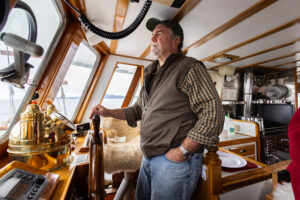
Above is the opening spread of a Cuba story that will appear in the April issue of PassageMaker magazine. By then we may know whether some of us will be able to take our boats to Cuba legally for the first time since 2004.
President Obama kicked off 2015 by announcing that U.S. foreign policy toward Cuba would shift from isolation to engagement. Almost immediately online boating forums came alive with chatter about when U.S. boaters would be allowed to cruise to the island legally. A heap of misinformation was spread, and with astounding certitude by those who knew the least.
The administration is about to implement changes that will make it much easier for U.S. citizens with a legal reason to visit Cuba to do so. It will expand the categories of travel that fall under the “general license” category, which involves almost no government paperwork. This is the people part of the equation.
What should most concern the cruising community is the process by which a U.S. boat is permitted to go to Cuba legally.
Before the administration of President George W. Bush cracked down on Cuba travel in 2004, U.S. citizens with a legal reason to visit Cuba–either under a general license or a specific license from the U.S. Treasury Department¾could make the trip on their own boat with certain restrictions.
The Bush crackdown effectively banned all U.S. recreational vessels from going to Cuba, even though there was a process for anyone patient enough to try.
The Bush regs required that any boat owner wanting to sail to Cuba obtain a “temporary sojourn license” from the U.S. Commerce Department, as if they owned a freighter. Think of the sojourn license as a temporary export permit.
Once made, the sojourn application was passed to the U.S. State Department, which has vetoed each and every one since 2004. According to State, these vetoes furthered “U.S. foreign policy interests.”
Ending the travel ban entirely, of course, would mean all of us would be free to take boats to Cuba, but that requires a vote of Congress, which continues to pander to minority factions against reconciliation with Havana.
But the administration has two options that would help restore the status quo ante. It could eliminate the 2004 requirement for a Sojourn License altogether, or at the very least the State Department could cease to summarily deny every license application without considering the merits.
U.S. boaters would again be able travel to Cuba as participants in sportfishing tournaments and sailing regattas. Boats filled with medical supplies and other scarce necessities would flow across the Florida Straits to be distributed to ordinary Cubans. Marine journalists could do the logical thing and go by boat.
In a recent open letter to President Obama and Secretary of State John Kerry, I urged policymakers to take the cruising community into account as it develops new regulations supporting our new policy of engagement.
“Cruisers can reach an entire segment of the Cuban population outside the Cuban tourism industry,” I wrote. “Cruisers will interact with ordinary Cubans, such as fishermen, shopkeepers, mechanics and other tradesmen. That is to say, they will do business with them, bringing a little bit of prosperity to ordinary people outside the tourism sphere.”
In any event, if you interested in how U.S. policy toward Cuba affects the cruising community, come back to www.passagemaker.com or check PassageMaker magazine. We are in contact with the State Department on this issue and will report developments as they happen.





